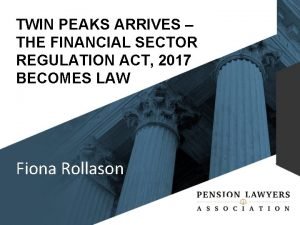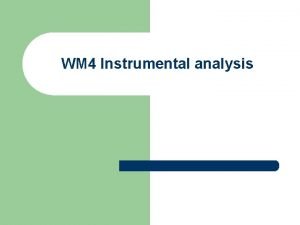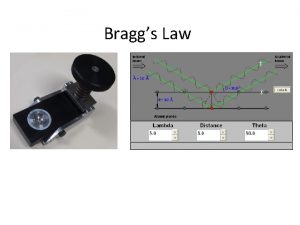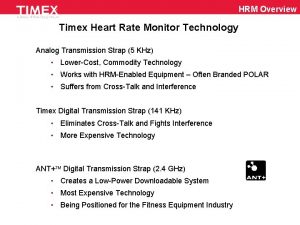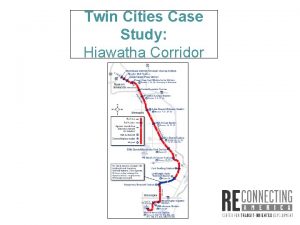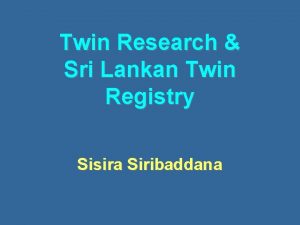Update on Twin Peaks system Discussion at the









































- Slides: 41

Update on Twin Peaks system Discussion at the Standing Committee on Finance National Treasury | 3 December 2019

Maps to a set of policy objectives 2

Existing laws under Twin Peaks Prudential Authority (established in FSRA) Banks Act Insurance prudential FST Market conduct Prudential Financial Sector Conduct Authority (established in FSRA) MMFs Prudenti al: FMIs, etc Insurance Market conduct CIS Control Act Pension Funds Act FAIS Act Financial Services Tribunal Financi al Market Act FSR Bill also provides authorities with some powers and duties in addition to those in current law to plug gaps Tribunal as single appeal mechanism for decisions of authorities across all laws

Joint Standard on Margin Requirements for Non. Centrally Cleared Derivatives Transactions Discussion at the Standing Committee on Finance National Treasury | 3 December 2019

Why was this submitted? • Subordinate legislation must be submitted to Parliament • The Financial sector Regulation Act (no 9 of 2017) requires all ‘subordinate legislation’ to be formally tabled in Parliament – Generally highly technical areas of financial sector requirements (e. g. calculation on how much capital banks must hold) – May not exceed the ambit of the Act • Must be consistent with the objectives of the Act • Must be made in terms of an empowering provision of the Act • Most important – there must a clear and transparent process for making of these requirements – Affected parties must be consulted in a meaningful way – Parliament is given a formal role • Importantly, because of the sheer volume of requirements, Parliament does not need to approve 5

Why was this tabled? (2) • The Joint Standard is made in terms of section 107 and 106 9(1)(a), 106(2)(a) and (e) Section 98 of Financial Sector Regulation Act • These sections determine the process for making the regulatory instruments and requires that – (a) publication of the draft regulatory instrument – Statement explaining the statement of need and impact – Invite the public to comment on the draft for at least 6 weeks – After complying with section 98 to submit to Parliament in terms section 103 (1) for 30 days while in session • The Authorities (Prudential Authority and Financial Sector Conduct Authority) have submitted the Joint Standard through National Treasury and the Minister of Finance to Parliament. • We can brief Parliament on what is contained if necessary 6

Contents • Key points - Background on Global Reforms on OTC Derivatives Market • Progress on Implementing Reforms • Requirements for the Joint Standard • Implementation Timelines 7

Committed to the Global Financial Market Reforms • • Post the financial crisis experienced 2007 - 2008 the Group of Twenty (G 20) leaders at the 2009 Pittsburgh Summit made commitment to strengthen international financial regulatory system through amongst others improving over-the-counter (OTC) derivatives markets that were contributors to the financial crisis – for increased transparency and regulation in order to mitigate systemic risks Leaders including South Africa at the 2009 Pittsburgh Summit committed to the following – – “All standardized OTC derivative contracts should be traded on exchanges or electronic trading platforms, where appropriate – All Standardised OTC derivatives transactions should be cleared through central counterparties – OTC derivative contracts should be reported to trade repositories. – Non-centrally cleared contracts should be subject to higher capital requirements. ” http: //www. g 20. utoronto. ca/2009 communique 0925. html – Furthermore in 2011 – the G 20 agreed that non-centrally cleared derivatives should be subject to margin requirements and tasked the Basel Committee on Banking Supervision (BCBS) and International Organisation of Securities Commission (IOSCO) to develop consistent standards. 8

Proposed Approach to Implementing Reform Areas • • National Treasury published policy paper in 2012 – Reducing the risks of over-the-counter derivatives in South Africa – http: //www. treasury. gov. za/legislation/bills/2012/FMB/Annexure%20 B%20 Reducing%20 the%20 Risks%2 0 of%20 OTC%20 Derivatives. pdf Highlighted approach to implement the reforms – Proposed to follow a phased implementation approach - OTC Derivatives Reform Areas Risk management- Margin Code of Conduct and Standardisation, Central and Capital requirements for Registration of Market Clearing and central trading non centrally cleared participants, Central - where appropriate derivatives (where Reporting appropriate) 9

SA Progress to date • South African authorities have continued to implement the reforms to OTC derivative markets, aligned with international standards and principles. • Reforms implemented through legislative and regulatory reforms: – The Financial Markets Act (19 of 2012) provides the enabling framework to regulate OTC derivatives activities – effective 2013 and further consequential amendments – The Regulations under the FMA include additional requirements - effective in February 2018 – The Financial Sector Regulation Act ( 9 of 2017) – includes empowering provisions for the Prudential Authority and the Financial Sector Conduct Authority to issue additional requirements – effective April 2018 – – • The Joint Standards and Conduct Standards have been issued in 2018 – • The Criteria for authorisation of OTC derivatives providers (ODPs) • Conduct requirements applicable to authorised ODPs • Trade reporting obligations for OTC derivatives providers • Joint standard on the requirements and additional duties of a trade repository Joint Standard on Margin Requirements for non-centrally cleared OTC derivatives - currently tabled Other requirements implemented through Basel III requirements – Interim Capital Requirements i. e. CVA 10

Monitoring Implementation of Reforms • The reforms a part of a global agenda, the Financial Stability Board (FSB) continues to monitor implementation and progress made by jurisdictions • South African authorities annually submit their status updates included in the FSB reports – “OTC Derivatives Markets Reforms - 2019 Progress Report on Implementation” published in November 2019 • Report notes “limited progress” reported since November 2018 report available at https: //www. fsb. org/2019/10/otc-derivatives-market-reforms-2019 -progress-report-on-implementation/ • Further work is underway to meet implementation timelines – continued reassessment of reform areas and their impacts by working groups of the FSB • South Africa also implementing reforms in consideration of the domestic setup 11

Implementation of Margin Requirements • Requirements based on BCBS-IOSCO recommendations finalized in March 2015 (including amendments in July 2019). (https: //www. bis. org/bcbs/publ/d 475. pdf ) • Purpose of the Margins – Mitigate risks from OTC derivative transactions that are faced by counterparties in bilateral transactions where the risk is not covered by the central counterparty(CCP) – Margin/Collateral is Initial Margin (bilateral exchange and onset of the Transaction) and Variation Margin (through out the term of the contract on a daily basis – after marking to market valuation) – What do margins do? • Creates a “safety net” – margins (collateral) will be exchanged by counterparties • to reduce the risk exposure/loss suffered by a counterparty in case of a default on the obligations 12

SA making progress but still lagging 13

Progress on Margin Requirements Frameworks • 16 / 24 jurisdictions have implemented • BCBS-IOSCO amended final phase in date – to address implementation challenges – Previous final implementation phase in was 1 September 2020 – New final implementation phase in – 1 September 2021 • Brazil implemented requirements as of 1 September 2019 • US extended to non bank swap dealers • Overall higher collateralisation rates were reported (largely in equity and credit OTC derivatives) • SA framework to be finalized – • First phase in 1 October 2020* BCBS- IOSCO Working Group will continue to assess implementation – noted differences in implementation of the framework i. e. treatment and segregation of margin; scope of products & entities; substituted compliance/equivalence assessments • Implementation challenges remain – uncertainty over treatment of legacy contracts with implementation interest rate benchmarks resulting in amending contracts, BCBS-IOSCO clarified that margin requirement not required in this instance and no documentation specified if covered entity is below threshold. 14

PA and FSCA updates Requirements in the joint standard on margin requirements for non-centrally cleared OTC derivatives transactions 15

Impact and Intended operation of a regulatory instrument. • Joint standards are drafted in terms of section 107, read with 106(1)(a), 106(2)(a) and (e), of the Financial Sector Regulation Act, 2017 (Act No. 9 of 2017). Scope of application of the Joint Standard - All non-centrally cleared OTC derivative transactions of an ODP with a defined counterparty or foreign counterparty - ODPs; Authorised users; banks, financial services providers, insurers; investment fund; or any other person defined as counterparty by the FSCA with concurrence of PA Exclusions - Sovereigns – defined as central government and includes the central government in the Republic of South Africa as constituted by the national sphere of government, excluding any national public entity or national government business enterprise as defined in the PFMA Act - Central banks; Multilateral development banks and Bank for international settlement - Excludes physically settle foreign exchange forward contracts and foreign exchange swaps - Repurchase agreements and securities lending transactions that are not derivatives - Indirectly cleared transactions intermediated through a clearing member - In the case of cross currency swaps, the initial margin requirements do not apply to any fixed physically settled foreign exchange transactions associated with the exchange of principal, which have the same characteristics as a foreign exchange forward contract, is excluded from the initial margin 16

BCBS-IOSCO framework into domestic regulatory framework. BCBS-IOSCO Framework Policy approach by the Authorities (SA) Thresholds: Reference to foreign currency (Euros) in setting the thresholds The Authorities adopted a set conversion rate of € 1: R 10 to convert the foreign currency thresholds into Rands in the domestic legal framework. Scope of coverage: covered entities are financial firms and systemically In order to ensure close alignment with the BCBS-IOSCO Framework it is important non-financial firms (covered entities). The precise definition of proposed that the scope of coverage of the Joint Standard be applied to OTC financial firms, non-financial firms and systemically important non-financial Derivative Providers (providers) and counterparties as defined in the Joint firms will be determined by appropriate national regulation. Standard. The Joint Standard also allows the Authorities to declare any other person as a counterparty. This will allow the Authorities the flexibility to bring other entities within the scope of the Joint Standard. Intra-group transactions: the specific legal and regulatory frameworks The Authorities do not support an outright exemption from the margin governing inter-affiliate derivative transactions depend largely on specific requirements for intra-group transactions. The Joint Standard provides that the features of applicable jurisdictions non-centrally cleared OTC derivative transactions between a provider and a counterparty belonging to the same group, below an aggregate outstanding gross notional amount of R 100 billion. 3

BCBS-IOSCO framework into domestic regulatory framework. BCBS-IOSCO Framework Policy approach by the Authorities (SA) Cross-border OTC derivative transactions: home-country supervisors may A local counterparty that enters into an OTC derivative transaction with a permit a covered entity to comply with margin requirements of a host-country foreign counterparty is deemed to comply with the Joint Standard provided that with respect to its derivatives activities, provided that the home-country the local provider has satisfied itself that (i) the foreign jurisdiction has supervisors consider the host-country margin regime to be consistent with the implemented margin requirements based on the BCBS-IOSCO Framework; margin requirements in the BCBS-IOSCO Framework. (ii) the foreign counterparty is directly subject to such margin requirements; and (iii) the local counterparty is required to comply with, or is captured by, the margin requirements in the foreign jurisdiction. Treatment of physically settled FX forwards and swaps: the BCBS and Physically settled FX forwards and swaps are excluded from VM in line with IOSCO agree that standards apply for variation margin to be exchanged on other jurisdictions. In this regard, the Authorities are concerned around the physically settled FX forwards and swaps in a manner consistent with the final practicality of requiring local ODPs to be subjected to VM for these policy framework set out in the BCBS-IOSCO framework and that those transactions if the counterparty in another jurisdiction is not required to variation margin standards are implemented either by way of supervisory exchange VM. The Authorities do not support excluding physically settled FX guidance or national regulation. forward and swap transactions from the calculations of the daily intragroup threshold – these transactions are also taken into account in the calculation of the IM threshold even though these transactions are not subject to the exchange of IM. 1

Phased in Implementation Timeline Initial Margin Application Aggregate Month End Gross Notional Amounts IM Threshold Effective date of joint standard to 31 August 2021 Transactions between a Provider and counterparty belonging to a group with aggregate month end gross notional amount for March, April and May 2020 Exchange if threshold is > R 30 trillion 1 September 2021 – 31 August 2022 - March, April and May 2021 > R 23 trillion 1 September 2022 – 31 August 2023 - March, April and May 2022 >R 15 trillion 1 September 2023 – 31 August 2024 - March, April and May 2023 > R 8 trillion From 1 September 2024 onwards - March, April and May of that year (xxxx) > R 100 billion Variation Margin Aggregate Month End Gross Notional Amounts VM Threshold Effective date of joint standard 1 October 2020 – applies to new contracts entered after effective date Transactions between a Provider and counterparty belonging to a group with aggregate month end gross notional amount for March, April and May 2020 Exchange if threshold is > R 30 trillion Minimum Margin Transfers subject to R 5 million 6 Months after effective date – applicable to new contracts only No thresholds apply 19

DRAFT FINANCIAL SECTOR REGULATIONS, 2018 | National Treasury presentation to the Standing Committee on Finance 16 March 2018

Amendments to Regulations in terms of Financial Sector Regulation Act • • • The Minister of Finance has published draft amendments to the Financial Sector Regulations for public comment. The Regulations were made in terms of sections 61(4), 288 and 304 of the Financial Sector Regulation Act No. 9 of 2017, published in Government Notice No. R 405 of 29 March 2018, as amended. The process to appoint a Commissioner and Deputy Commissioner of FSCA commenced in April 2018, after the appointment of the Shortlisting Panel as per requirements of the Regulations. The Panel held several meetings to fulfil its requirement of shortlisting four candidates for consideration by then Minister of Finance (Minister). Given the rigidity of the current regulated process, the Panel was not able to identify four candidates for recommendation to the Minister. The terms of office of two members, a Deputy Governor of the South African Reserve Bank and the National Consumer Commissioner, have also subsequently expired. The above developments have necessitated amendments to the regulations. Amendments are proposed to regulations 3, 9, 10 and 11 of the current regulations, which seek to: – Streamline the recruitment process for the Commissioner and Deputy Commissioners. – Empower the Minister to appoint additional persons to the Transitional Management Committee of FSCA, and to appoint one such person to act as Commissioner while the recruitment process is underway. – Clarify how vacancies to the Shortlisting panel should be handled. 21

Purpose of Regulations (2) • The Minister of Finance is required to make Regulations in terms of section 61(4) of the FSRA, to provide a process for the selection of persons for the appointment of the Commissioner and Deputy Commissioners of the Financial Sector Conduct Authority. • The draft Regulations provide for the advertising of the positions, and for the establishment of panels to consider, short-list, interview, and recommend candidates for appointment to the Minister of Finance. • The intended effect of the draft Regulations is to provide for a fair and transparent process for the appointment of the Commissioner and Deputy Commissioners of the Financial Sector Conduct Authority. 22

Process • On 18 December 2017, draft Regulations were published on the National Treasury website for comment, and a Notice of that publication was published in the Government Gazette. • The required six week period for public comment was completed on 31 January 2018. • Prior to finalising and promulgating the Regulations in the Government Gazette, the draft Regulations must be submitted to Parliament for consideration, for a period of at least 30 days while Parliament is in session. • The draft Regulations were submitted to Parliament on 15 February 2018. • Regulations need to be promulgated prior to the establishment of the Prudential Authority, Financial Sector Conduct Authority, and the Financial Services Tribunal on 1 April 2018. 23

Documents circulated to the Standing Committee on Finance (as required in terms of s 288(4) of the FSRA) • Draft Regulations published for public comment in December 2017 (Document “A”) • A statement explaining the need for and the intended operation of the Regulation and the version of draft Regulations that were published for public comment in December 2017 (Document “B”, published on website as cover page for draft Regulations); • A statement of the expected impact of the Regulation (see Document “B” and Impact Assessment for the Financial Sector Regulation Bill (see Document “C”); • Notice published in the Government Gazette inviting submissions in relation to the Regulation and stating where, how and by when submissions are to be made (Annexure “D”); and • A report of the consultation process (Document “E”), which includes– a general account of the issues raised in the submissions; and – a response to the issues raised in the submissions. 24

Documents circulated to Committee (2) • A proposed revised version of the Regulations, containing revisions in light of comments (indicated in Document “E” as being proposed to be accepted by the National Treasury). • The proposed changes are indicated as track changes. • A few additional refinements are proposed to ensure clarity and legal certainty of the provisions. ) 25

Summary of Regulations • Regulation 1 provides for certain necessary definitions in the Regulations. • Part 1 of the Regulations transitional measures. addresses necessary • Part 2 of the Regulations addresses the appointment of the Commissioner and Deputy Commissioners of the Financial Sector Conduct Authority. 26

Part 1 - Transitional Measures Regulation 2 • Regulation 2 addresses the issue of who would exercise powers if provisions of the Financial Sector Regulation Act come into operation prior to the establishment of the Prudential Authority (“PA”) and the Financial Sector Conduct Authority (“the FSCA”) (collectively, “the financial sector regulators”) • Regulation 2(1)- if any provisions of the FSRA come into operation prior to the PA being established— – a reference in a financial sector law, other than the Financial Markets Act, to the ‘Prudential Authority’, or a reference to ‘a financial sector regulator’, must be read as referring to or as including a reference to the Reserve Bank; – the Reserve Bank must perform the functions of the Prudential Authority as set out in section 34 of the Act; – in respect of the Financial Markets Act, section 1 A of that Act applies (which designates the exercise of powers in terms of that Act). 27

Part 1 - Regulation 2 (Cont. ) • Regulation 2(2)- if any provisions of the Act come into operation prior to the establishment of the Financial Sector Conduct Authority— – a reference in a financial sector law to the ‘Financial Sector Conduct Authority’, or a reference to ‘a financial sector regulator’, must be read as referring to or as including a reference to the Financial Services Board; – the executive of the Financial Services Board, referred to in section 9 of the Financial Services Board Act, must perform the functions of the Financial Sector Conduct Authority in terms of the Act; – the executive officer of the Financial Services Board, referred to in section 1 of the Financial Services Board Act, must perform the functions of the Financial Sector Conduct Authority in terms of legislation referred to in paragraph (b), (c) or (d) of the definition of a financial sector law in section 1(1) of the Act, subject to a delegation under section 20(3) or (3 A) of the Financial Services Board Act; – in respect of the Financial Markets Act, section 1 A of that Act applies. 28

Part 1 - Regulation 2 (Cont. ) • Regulation 2(3)- If the Financial Sector Conduct Authority is established prior to the Fees and Levies Chapter, Chapter 16, comes into effect, a reference to the board in sections 15 A and 16 of the Financial Services Board Act must be read as a reference to the Financial Sector Conduct Authority. • This is to make it clear that the Financial Sector Conduct Authority could continue to be funded for an interim period in accordance with the Financial Services Board Act until the forthcoming Financial Sector Levies Bill is enacted. • Only one minor revision is proposed for this Regulation to promote clarity (regulation 2(1)(b)). 29

Part 1 - Regulation 3 • Regulation 3 deals with the management of the transitional process to establish the FSCA. • Regulation 3(1)- (a) If Chapter 4 of the Act comes into effect before the appointment of the Commissioner and Deputy Commissioners, the executive of the Financial Services Board referred to in section 9 of the Financial Services Board Act, acting under the oversight of the Financial Services Board, must perform the functions of the Executive Committee of the Financial Sector Conduct Authority, to facilitate the disestablishment of the Financial Services Board and the establishment of the Financial Sector Conduct Authority in an efficient and effective manner with the least disruption, until the persons appointed as the Commissioner and Deputy Commissioners have all commenced service. • A slight refinement of wording is proposed, to enhance clarity. 30

Part 1 - Regulation 3 (Cont. ) • Proposed Regulation 3(1)(b) and (c)- to provide additional clarity and certainty: (b) Any decision taken by the executive of the Financial Services Board during the transitional period referred to in subparagraph (a) is regarded as having been taken by the Financial Sector Conduct Authority. (c) A person designated by the executive of the Financial Services Board must perform the functions of the Commissioner in terms of sections 22 and 79 the Act, until the person appointed as the Commissioner has commenced service. • Paragraph (c) relates to who would act in the position of the Commissioner on the Financial Stability Oversight Committee and the Financial System Council of Regulators. • Regulation 3(2) sets out the functions that the executive of the Financial Services Board could perform while acting as the Executive Committee of the Financial Sector Conduct Authority. One minor wording change to 31 more generally refer to the functions of the Executive Committee in s.

Part 1 - Regulation 3 (Cont). • Regulation 3(3) addresses how funding will be handled by the executive committee of the FSB during the transitional period of the establishment of the FSCA. (very minor wording change proposed- for clarity). • Regulation 3(4)- the members of the executive committee of the FSB would continue to act in an advisory capacity for a six month period after the Commissioner and Deputy Commissioners of the FSCA are appointed. • Regulation 3(5) addresses how the reporting of financial statements will be handled during the transitional period. 32

Part 1 - Regulation 4 • Regulation 4 addresses the establishment of the Financial Services Tribunal • Regulation 4(1) provides that the FSB/FSCA must provide the necessary initial secretarial, administrative and other support for the Tribunal, and an agreement will be entered into between the FSCA and the PA to provide for the sharing of costs, until 1 April 2019, when the Financial Sector Levies Bill, once enacted, would raise levies for the functioning of the Tribunal. • Regulation 4(2) addresses what rules, regulations, guidelines, etc. , would be applied by the Tribunal to handle cases during the period from its establishment on 1 April 2018, until the Chairperson of the Tribunal may designate Tribunal Rules. • During this period, either the existing rules, regulations, etc. , of the existing Appeal Board of the FSB and the Board of Review in terms of the Banks Act could be jointly designated by the existing Chairpersons of the Board of Review and Appeal Board as being applicable, or, if no 33 designation is made prior to the Tribunal being established on 1 April, the

Part 1 - Regulations 5 and 6 • Regulation 5 deals with how documents that are required to be published on the Register must be published prior to the Register being established, as the Register cannot be established immediately. • Regulation 6 clarifies the appropriate interpretation of certain provisions in the Act, due to the fact that those sections refer to “Chapter”, “Part” or ‘’section”, and it will be necessary to bring different provisions of the Chapter, Part and section referred to into operation at different times, and so there would not be a single date on which the “Chapter”, “Part” or “section” referred to would come into operation. 34

Part 2 - Appointment of Commissioner and Deputy Commissioners of Financial Sector Conduct Authority • Regulation 7 addresses advertising of the positions of Commissioner and Deputy Commissioner. – Only a very minor refinement to the wording is proposed. • Regulation 8 sets out requirements for applications for the positions. – Only a very minor typographical correction is proposed. 35

Part 2 - Regulation 9 • Regulation 9 provides for the establishment of a Shortlisting panel for the vetting of applications and the shortlisting of candidates, and sets out certain requirements relating to its functioning. • In response to comments that some specification of expertise for the panel should be indicated, the following revised wording for subregulation (2) is proposed. 36

Part 2 - Regulation 9(2)(a) “(2)(a) For the purposes of shortlisting persons for the first appointment of the Commissioner and Deputy Commissioners in terms of the Act, the Shortlisting Panel consists of— (i) the Director-General or a Deputy Director-General of the National Treasury nominated by the Director-General as chairperson; (ii) the Chairperson of the Financial Services Board; (iii) a Deputy Governor of the Reserve Bank nominated by the Governor; (iv) the Commissioner of the National Consumer Commission appointed in terms of section 87 of the Consumer Protection Act, 2008 (Act No. 68 of 2008) or that Commissioner’s nominee; (v) a representative of the Ethics Institute of South Africa or the Institute of Directors in Southern Africa or any other body that focuses on ethics and good governance in the financial sector, designated by the Director-General of the National Treasury; and (vi) one person designated by the Minister who has suitable experience and expertise in the financial sector, and knowledge of the financial sector, that enables them to appropriately consider and assess the suitability of applicants 37 for appointment as Commissioner or Deputy Commissioner. ”

Part 2 - Regulation 9(2)(b) “(b) For the purposes of subsequent appointments of the Commissioner and Deputy Commissioners, the Shortlisting Panel consists of— (i) the Director-General or a Deputy Director-General of the National Treasury nominated by the Director-General as chairperson; (ii) a Deputy Governor of the Reserve Bank nominated by the Governor; (iii) the Commissioner of the National Consumer Commission appointed in terms of section 87 of the Consumer Protection Act, 2008 (Act No. 68 of 2008) or that Commissioner’s nominee; (iv) a representative of the Ethics Institute of South Africa or the Institute of Directors in Southern Africa or any other body that focuses on ethics and good governance in the financial sector, designated by the Director-General of the National Treasury; and (v) one person designated by the Minister who has suitable experience and expertise in the financial sector, and knowledge of the financial sector, that enables them to appropriately consider and assess the suitability of applicants for appointment as Commissioner or Deputy Commissioner. ” 38

Part 2 - Regulation 10 • Regulation 10 provides for the appointment of a Ministerial Panel to interview shortlisted candidates and recommend a preferred candidate for appointment to the positions of Commissioner and Deputy Commissioner. • Similar comments were received as were made in relation to Regulation 9, and so amendments are proposed to regulation 10(1): “(1) The Minister must convene a Ministerial Panel to interview candidates shortlisted by the Shortlisting Panel, which includes— (a) the Minister as Chairperson; (b) the Director-General; (c) the Governor or a Deputy Governor of the Reserve Bank nominated by the Governor; and (d) one other person designated by the Minister who has suitable experience and expertise in the financial sector, and knowledge of the financial sector, that enables them to appropriately consider and assess the suitability of 39 applicants for appointment as Commissioner or Deputy

Part 2 – Regulations 11 and 12 • Regulation 11 sets out criteria for candidates to be suitable for shortlisting and interviewing and appointment as Commissioner and Deputy Commissioners, in addition to what is provided in section 61 of the FSRA. – These criteria are intended to ensure that strongly qualified candidates, with a range of appropriate expertise and experience, are appointed to these critical positions in the FSCA. • Regulation 12 provides for the short title and commencement, and the regulations need to come into operation prior to 1 April 2018. 40

THANK YOU QUESTIONS? 41
 Twin peaks financial regulation
Twin peaks financial regulation Twin-twin transfusion syndrome
Twin-twin transfusion syndrome Rumus twin twin
Rumus twin twin What is an alternative of log based recovery
What is an alternative of log based recovery Salicylic acid ir spectrum peaks labeled
Salicylic acid ir spectrum peaks labeled Mountain peaks of prophecy
Mountain peaks of prophecy A thousand peaks and myriad ravines
A thousand peaks and myriad ravines Diamond xrd peaks
Diamond xrd peaks Resource allocation vs resource leveling
Resource allocation vs resource leveling Bragg equation
Bragg equation Land with steep sides and sharp peaks
Land with steep sides and sharp peaks Peaks of otter
Peaks of otter Training peaks login
Training peaks login Frankenthaler mountains and sea
Frankenthaler mountains and sea Simple distillation discussion
Simple distillation discussion Advantages of twin pipe air brake system
Advantages of twin pipe air brake system Dtsi full form
Dtsi full form Hát kết hợp bộ gõ cơ thể
Hát kết hợp bộ gõ cơ thể Frameset trong html5
Frameset trong html5 Bổ thể
Bổ thể Tỉ lệ cơ thể trẻ em
Tỉ lệ cơ thể trẻ em Chó sói
Chó sói Tư thế worm breton là gì
Tư thế worm breton là gì Alleluia hat len nguoi oi
Alleluia hat len nguoi oi Kể tên các môn thể thao
Kể tên các môn thể thao Thế nào là hệ số cao nhất
Thế nào là hệ số cao nhất Các châu lục và đại dương trên thế giới
Các châu lục và đại dương trên thế giới Công của trọng lực
Công của trọng lực Trời xanh đây là của chúng ta thể thơ
Trời xanh đây là của chúng ta thể thơ Mật thư anh em như thể tay chân
Mật thư anh em như thể tay chân Phép trừ bù
Phép trừ bù Phản ứng thế ankan
Phản ứng thế ankan Các châu lục và đại dương trên thế giới
Các châu lục và đại dương trên thế giới Thể thơ truyền thống
Thể thơ truyền thống Quá trình desamine hóa có thể tạo ra
Quá trình desamine hóa có thể tạo ra Một số thể thơ truyền thống
Một số thể thơ truyền thống Cái miệng nó xinh thế chỉ nói điều hay thôi
Cái miệng nó xinh thế chỉ nói điều hay thôi Vẽ hình chiếu vuông góc của vật thể sau
Vẽ hình chiếu vuông góc của vật thể sau Nguyên nhân của sự mỏi cơ sinh 8
Nguyên nhân của sự mỏi cơ sinh 8 đặc điểm cơ thể của người tối cổ
đặc điểm cơ thể của người tối cổ Thế nào là giọng cùng tên
Thế nào là giọng cùng tên Vẽ hình chiếu đứng bằng cạnh của vật thể
Vẽ hình chiếu đứng bằng cạnh của vật thể
